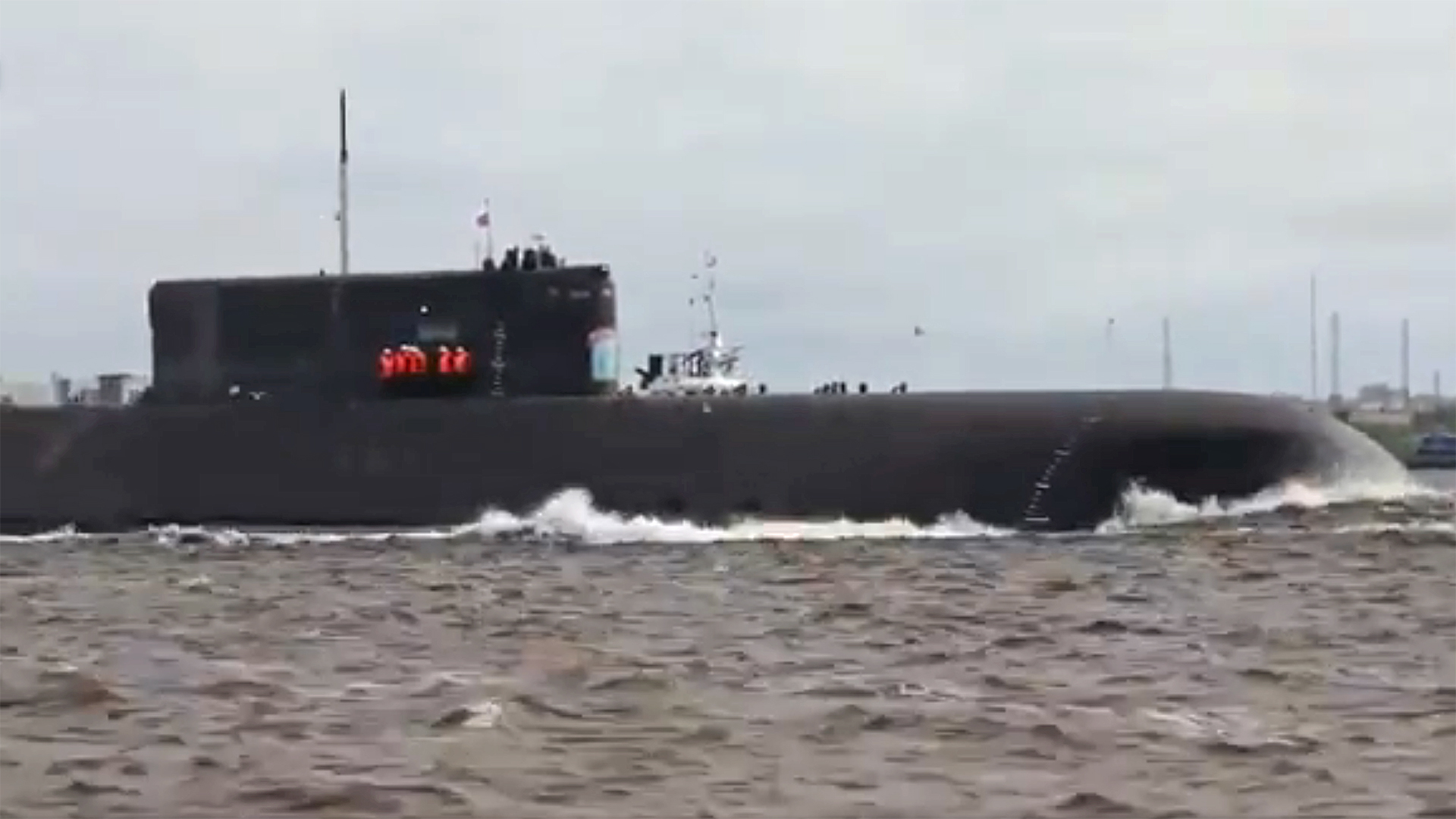The shadowy K-329 Belgorod, the world’s longest submarine, which was designed to carry nuclear-powered, nuclear-tipped, long-range torpedoes, is now in service with the Russian Navy.
The Belgorod was turned over to that nation’s sea service in a ceremony at the Sevmash shipyard in Severodvisnk Friday, according to the Sevmash website.
Touted by the Russians as a “research” vessel able to conduct “diverse scientific expeditions and rescue operations in the most remote areas of the World Ocean,” Belgorod is, in reality, a massive underwater weapons system that can deliver devastating strike capability and serve as a mothership for a host of undersea platforms. A highly modified Oscar II-class nuclear-powered guided-missile submarine, Belgorod is about 600 feet long, has two OK-650V nuclear power plants capable of providing 190 megawatts each, and has an undersea displacement of nearly 24,000 tons, according to GlobalSecurity.org.
Belgorod will apparently be the first boat to be armed with the 2M39 Status-6 or “Poseidon” intercontinental nuclear-powered, nuclear-armed autonomous torpedoes, of which it can carry six.
One of Vladimir Putin’s six so-called ‘super weapons’ highlighted in a fiery address in 2019, Poseidon’s main job is to strike at coastal installations with little to no warning. It reportedly has an especially dirty warhead, which means it would not only cause immediate damage, but also contaminate the area with radiation and impede any continued operations or repairs. Attacks could be executed by creating a radioactive tsunami. The weapon has extreme endurance and could be held out to see for long periods prior to an attack after being launched from thousands of miles away. It’s a nuclear delivery system designed directly to mitigate any American missile defense capabilities.
In February 2019, the Russian Ministry of Defense had released the video below, claiming to show an underwater test of the weapon. An earlier video gave a clearer view of its configuration.


You can read more about the Poseidon in our deep dive here.
The vessel will also be capable of carrying deep-sea drones, a deep-diving nuclear-powered minisub, and a submersible nuclear power plant designed to power an undersea sensor network.

Investigating, manipulating, or retrieving relatively small objects deep underwater, such as submarine cables on the sea floor, is one of the main functions of Russian special mission submarines. To do that requires fine movements and the ability to “hover” using small thrusters in a relatively stable position underwater.
This might also explain the reinforced lower rudders if Belgorod is at all expected to “land” on the seabed during certain missions. Other subs Russia has outfitted for special missions, as well as American ones, have featured retractable skids to help support them on the seafloor.
Such hovering capability could be key to launching and recovering manned or unmanned submarines. In 2015, in what appears to have been a deliberate leak, a briefing slide appeared in a Russian state television broadcast that showed Belgorod with a smaller submarine nestled in the underside of its hull. It’s not clear what this other submarine was, but some have posited that it could be the equally shadowy Project 10831 Losharik nuclear-powered midget submarine.
In 2019, 14 Russian sailors were killed in an accident aboard Losharik. The deep-diving submarine is being repaired and will return to the fleet, according to the Russian Navy.
The Oscar II-class guided missile submarines are already some of the largest in the world. Their hullform is notably very wide to accommodate 24 huge P-700 Granit anti-ship cruise missiles housed in long compartments located between the outer and inner hulls on each side of the submarine. Refitting will see the P-700 replaced with common launch cells that can hold up 72 Kalibr or Onix cruise missiles.
Belgorod‘s refit added nearly 100 feet to the boat’s overall length. This makes the K-329, also known as the Project 09852, longer than even the monstrous Soviet-era Typhoon-class ballistic missile submarines, of which only one remains in limited service with the Russian Navy.
We’ve profiled the development of the vessel, which you can read about here.

Having Belgorod now in service gives the Russian Navy an undersea strike and intelligence platform that can accomplish a wide variety of missions. It can launch Posideon torpedoes that can destroy cities from afar. It can locate and manipulate objects on the ocean floor, including communications cables that it can either potentially tap or cut, blinding adversaries. And it gives Russia another tool to dominate the quickly opening Arctic, where melting ice may provide intercontinental sea routes that could be shorter than transiting the Suez Canal.
Though decades in the making, the Russian Navy has finally put into operation one of its most versatile and feared weapons.
Contact the author: howard@thewarzone.com
